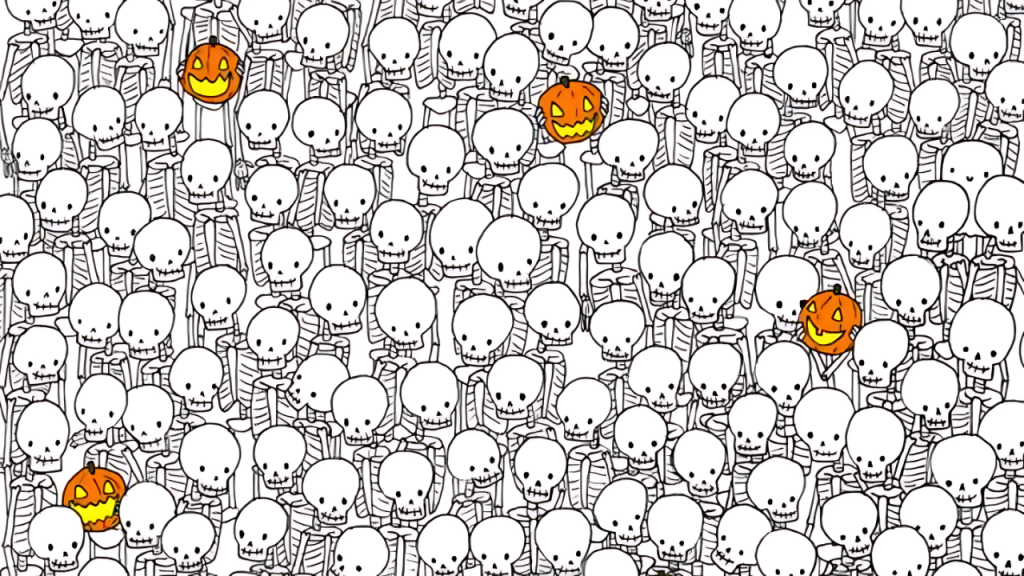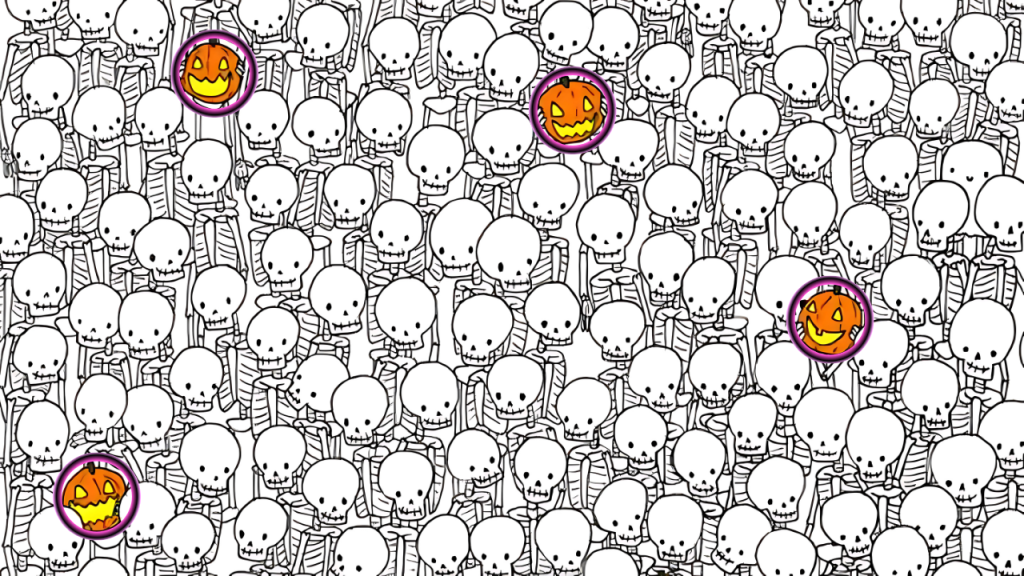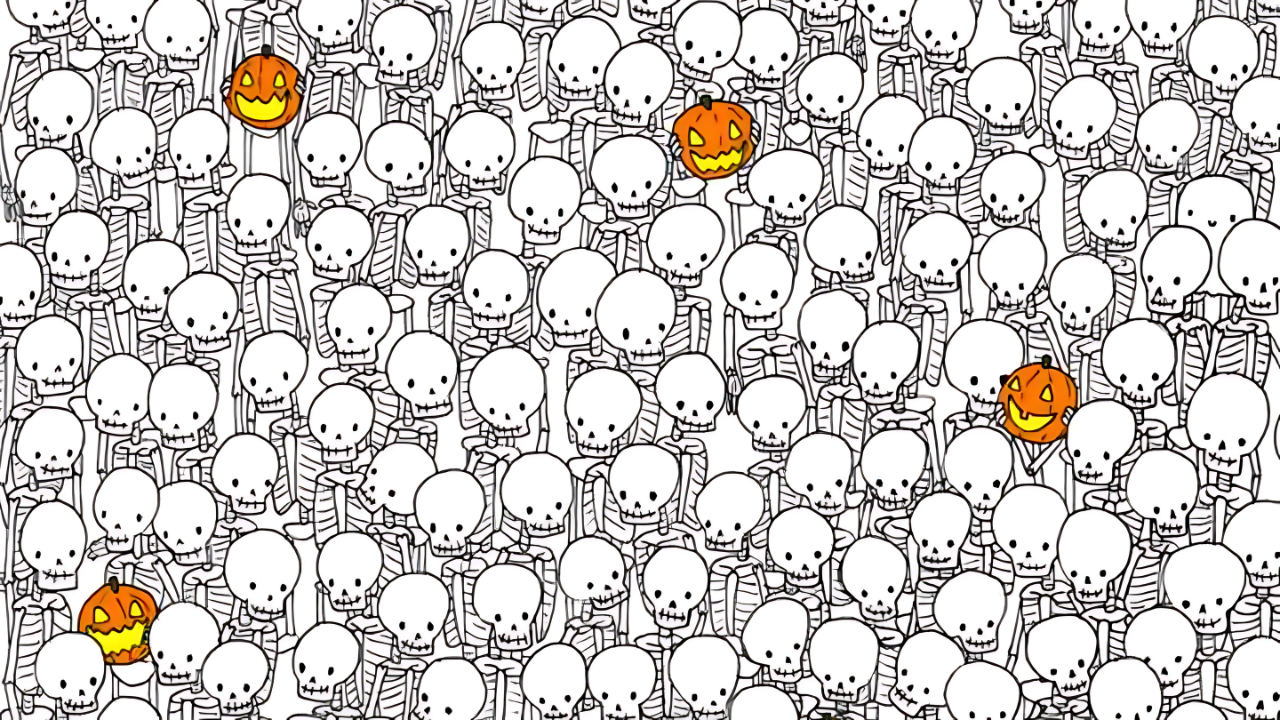Halloween brings a peculiar magic to our world – a time when the veil between our reality and the supernatural supposedly thins. This spooky season has forever been linked with ghost stories, haunted attractions, and the thrilling experience of facing our fears in playful ways.
A particularly challenging optical illusion has recently captured widespread attention online, revealing something unexpected about the rare individuals who can solve it quickly. The image appears to be a simple autumn scene with a rustic cabin nestled among colorful fall foliage, but it harbors several cleverly concealed ghostly figures.
The Viral Ghost Hunt That Captivated Social Media
What started as a modest Halloween puzzle on a small paranormal forum has exploded into an internet sensation. The mysterious image has been shared millions of times across platforms, collecting frustrated comments, victorious discoveries, and heated debates.
“I’ve stared at this for twenty minutes and still only found three ghosts!” reads one typical comment that garnered thousands of supportive reactions. Meanwhile, others claim immediate success: “Spotted all five in under ten seconds—are people really having trouble with this?”
The digital artist behind this viral sensation, Sophia Winters, seems to enjoy the confusion her creation has sparked. “The beauty of perception puzzles is how they reveal the unique ways different brains process visual information,” Winters explained in a recent interview.
She purposely refuses to confirm exactly how many spectral entities hide within the image. “Perhaps some people see ghosts that others cannot, both in my artwork and in life,” she suggests mysteriously.

Why This Illusion Challenges Even the Sharpest Eyes
Unlike simpler optical illusions that rely on a single visual trick, this Halloween challenge incorporates multiple deception techniques to conceal its ghostly subjects. Some spirits utilize pareidolia—our tendency to see meaningful patterns like faces in random visual stimuli.
Others employ negative space, existing in the gaps between more obvious elements—spaces between tree branches or patterns in weathered wood. Several ghosts use subtle color variations that barely register to the human eye, appearing almost as slight texture differences rather than distinct forms.
The most difficult specters to spot incorporate what scientists call “change blindness”—they hide in plain sight but in areas where viewers typically don’t focus their attention. Lighting plays a crucial role, with some ghosts becoming more or less visible depending on screen brightness and viewing angle.
The Science Behind Ghost-Spotting Abilities
Research in visual cognition suggests that certain individuals possess natural advantages when detecting patterns hidden within complex scenes. Those with higher than average “field independence”—the ability to identify relevant information within distracting backgrounds—consistently perform better on tests like this ghostly challenge.
Professional backgrounds seem to correlate with success rates. Architects, designers, hunters, and those with military reconnaissance training show above-average performance in these tests. People who regularly engage with hidden object puzzles or certain video games may have developed neural networks specifically optimized for visual search tasks.
Personality traits might play a role as well, with more intuitive types often spotting hidden patterns more quickly than those with highly analytical cognitive styles. Age factors in surprising ways too – children between 8-12 years frequently outperform adults, possibly due to their less-established perceptual frameworks and greater cognitive flexibility.
Our Evolutionary Heritage of Pattern Recognition
Our ability to identify hidden figures—whether ghosts in an illustration or predators in dense foliage—has deep evolutionary roots. Early humans with superior pattern recognition capabilities enjoyed significant survival advantages, spotting camouflaged threats that others might miss.
This evolutionary heritage explains why we derive such satisfaction from visual puzzles that test these ancient neural pathways. Some anthropologists suggest that pareidolia developed as a protective mechanism, with false positives (seeing a predator that isn’t there) being less costly than false negatives (failing to notice a genuine threat).
Modern humans no longer rely on these skills for survival, but our brains retain the neural architecture that makes both genuine pattern recognition and occasional misidentification possible. The emotional component of searching specifically for “ghosts” may actually enhance perception by triggering mild arousal responses that sharpen attention.
Optical Illusion Answer

Winning Strategies from Those Who Spotted All Ghosts
Individuals who successfully identified all the hidden spirits frequently report employing specific viewing techniques rather than random scanning. One effective approach involves slightly unfocusing the eyes, similar to the technique used for viewing Magic Eye stereograms, allowing subtle patterns to emerge.
Another successful method requires systematically scanning the image in a grid pattern, spending equal time on each section rather than allowing the eye to naturally drift toward obvious focal points. Some viewers report better results when periodically blinking or looking away momentarily, which helps “reset” visual perception.
Adjusting screen brightness, viewing angle, or distance can dramatically impact success, with some ghosts becoming visible only under specific conditions. Counterintuitively, peripheral vision sometimes outperforms direct focus for detecting the most subtly integrated figures, as our visual periphery evolved to detect movement and pattern anomalies.
Groups working collaboratively tend to find more hidden elements than individuals working alone, as different viewers naturally attend to different aspects of the complex scene. This collaborative advantage highlights the unique perceptual strengths we each bring to visual challenges.
The Controversy: Special Ability or Just Practice?
The claim that only a small percentage of people can find all the hidden figures has sparked debate among vision scientists and perception researchers. Some experts suggest that the “exclusive ability” framing is primarily a marketing tactic rather than reflecting genuine perceptual differences.
“Most healthy adults should be able to locate these hidden elements given sufficient time and the right viewing conditions,” argues Dr. Marcus Chen, a visual cognition researcher. Others, like University of Edinburgh perception specialist Dr. Eleanor Harding, disagree: “There are indeed significant individual differences in pattern recognition capabilities.”
The controversy extends to disagreements about how many ghostly figures actually exist in the image, with counts ranging from five to twelve depending on how strictly one defines a “hidden ghost.” Some perception experts have pointed out that visual illusions often reveal cultural differences in attention patterns.
Western viewers typically focus on central objects while East Asian viewers more readily notice background elements and relationships. This cultural variation might explain why certain hidden ghosts are more frequently spotted by viewers from particular backgrounds than others.
Creating Your Own Halloween Illusions
Inspired viewers have begun creating their own versions of ghost illusions, sharing techniques for crafting images with hidden spectral figures. Digital artists recommend working with subtle transparency adjustments rather than obvious shape outlines when concealing figures within complex scenes.
Strategic use of pareidolia proves essential—placing elements that suggest faces or forms when viewed from certain perspectives but disappear from others. Effective illusions typically incorporate multiple difficulty levels, with some hidden elements relatively easy to spot and others requiring more sustained observation.
Color theory plays a crucial role, with the most challenging hidden elements often utilizing adjacent colors on the color wheel with similar luminance values but subtle hue differences. Creating convincing ghost illusions requires understanding both the physiology of human vision and the psychological principles that guide visual attention.
Beyond Entertainment: Real-World Applications
While this Halloween ghost illusion circulates primarily as entertainment, similar visual perception tests have serious applications across various professional domains. Military and law enforcement agencies use comparable hidden figure tests when screening candidates for roles requiring exceptional observational skills.
Medical professionals, particularly radiologists and pathologists, undergo training with similar pattern recognition challenges to improve their ability to detect subtle anomalies in diagnostic imagery. Archaeological surveys increasingly employ digitally enhanced imagery with techniques borrowed from perceptual illusions to help researchers identify ancient structures.
Air traffic controllers undergo regular testing with concealed pattern exercises to ensure their visual vigilance remains sharp. Software developers creating machine vision algorithms study human responses to these illusions to understand the strengths and limitations of biological visual processing systems they hope to replicate.
The Timeless Appeal of Visual Mysteries
Humans have been creating and enjoying concealed images since prehistoric times, with hidden figures appearing in cave paintings dating back thousands of years. This enduring fascination connects to fundamental aspects of human psychology—our love of puzzles, mysteries, and the satisfaction of discovery.
The specific Halloween theme adds an additional layer of appeal, connecting to ancient traditions of seeking contact with the unseen world during autumn. There’s something uniquely satisfying about the moment when a previously invisible pattern suddenly becomes obvious—what psychologists call the “aha moment” or perceptual shift.
This particular ghost illusion taps into our fascination with the boundary between perception and imagination, between what is demonstrably present and what might exist just beyond our normal awareness. In an era of digital manipulation and artificial reality, such illusions also prompt deeper questions about the nature of perception itself.
Will You See What Others Miss?
If you’re feeling inspired to test your perceptual abilities, the original Halloween ghost illusion can be found across various social media platforms by searching relevant terms. For optimal ghost-hunting results, try viewing the image on different devices and under various lighting conditions.
Don’t be discouraged if the hidden specters don’t immediately reveal themselves—according to the creator, the average viewer requires about three minutes to find the majority of the concealed figures. Consider setting a timer for your search, as knowing exactly how quickly you spotted the hidden ghosts provides a more accurate comparison.
The most commonly missed ghost reportedly appears in an area where viewers rarely focus their attention—a reminder that sometimes what we fail to see reveals more about our perceptual habits than about the image itself. Whether you spot all the ghosts instantly or struggle to find even one, the experience offers an entertaining glimpse into visual perception.
In the spirit of Halloween, perhaps the most important question isn’t how many ghosts you can find, but how many might be watching you while you search for them. The next time you see an ordinary scene, remember that extraordinary things might be hiding in plain sight—if only you know how to look.
Frequently Asked Questions
How many ghosts are actually hidden in the viral Halloween illusion?
The creator purposely refuses to confirm the exact number, with viewer counts ranging from five to twelve depending on interpretation.
Why can some people find the hidden ghosts instantly while others struggle?
Individual differences in visual processing, professional background, age, and cognitive style all contribute to varying success rates.
Does practice improve your ability to spot hidden patterns?
Yes, regular engagement with hidden object puzzles can strengthen the neural networks associated with pattern recognition.
What’s the best technique for finding hidden elements in optical illusions? Slightly unfocusing your eyes, using peripheral vision, and systematically scanning in a grid pattern are all effective approaches.
Are optical illusions just entertainment or do they have practical applications?
While entertaining, these visual puzzles have serious applications in fields including medicine, military, archaeology, and software development.
Do cultural differences affect how people perceive optical illusions?
Yes, research shows Western viewers typically focus on central objects while East Asian viewers more readily notice background elements and relationships.
Why do children sometimes outperform adults on these visual puzzles?
Children between 8-12 often have greater cognitive flexibility and less-established perceptual frameworks than adults.
What is pareidolia and how does it relate to optical illusions?
Pareidolia is our tendency to see meaningful patterns (like faces) in random stimuli – illusion creators strategically use this phenomenon.
Does viewing an illusion on different devices affect what you can see? Yes, screen brightness, resolution, and viewing angle can dramatically impact which hidden elements become visible.
Why are we so fascinated by optical illusions?
They connect to our evolutionary heritage of pattern recognition, while providing the psychological satisfaction of solving puzzles and experiencing “aha moments.”
